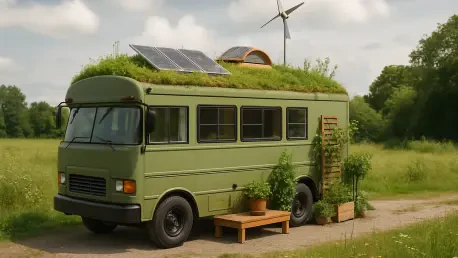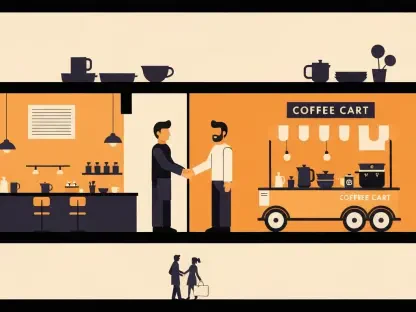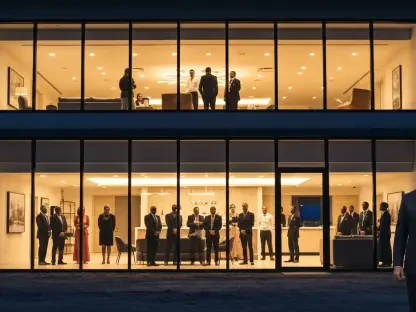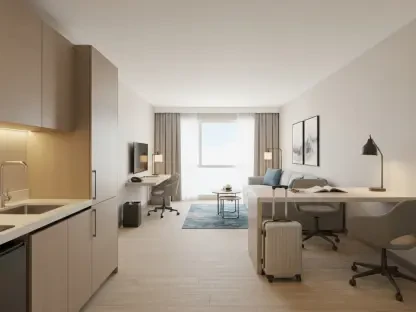In an era where sustainable living and minimalism are gaining traction, the story of an Australian couple, Kim and Ted, stands out as a remarkable example of ingenuity and environmental consciousness that inspires many. This pair has transformed a vintage 1966 Scottish double-decker bus into a fully functional tiny home that blends nostalgia with modern eco-friendly solutions. Weighing around 10 tons and towering at 4.3 meters, the bus might seem an unlikely candidate for a cozy residence, yet it offers a surprisingly livable space across two floors. The couple’s dedication to preserving original features, like the driver’s seat and exterior design, while incorporating contemporary upgrades, showcases a unique balance of heritage and innovation. Their journey not only highlights personal creativity but also taps into a broader movement of alternative housing that prioritizes reducing environmental impact. This narrative delves into how such transformations are redefining what comfortable living can mean within a smaller, more sustainable footprint.
Embracing Eco-Friendly Innovation
The heart of Kim and Ted’s tiny home lies in its commitment to sustainability, powered by an impressive array of renewable energy solutions. Eight solar panels mounted on the bus’s roof generate roughly 9 kilowatts of power daily, sufficient to run essentials like air conditioning on both levels and store backup energy for emergencies. This off-grid capability proved its resilience during a powerful cyclone last year, enduring winds of up to 140 kilometers per hour without faltering in structure or energy supply. Such durability underscores the potential for tiny homes to withstand harsh conditions while maintaining self-sufficiency. Beyond energy, the couple has integrated an electric heat incinerator toilet, a water-saving and plumbing-free option that further reduces their environmental footprint. These thoughtful choices reflect a deep dedication to eco-conscious living, demonstrating how alternative housing can align with modern demands for sustainability without sacrificing comfort or functionality.
Another aspect of their sustainable design is the focus on accessible green technology that others can adopt. While the couple’s setup is tailored to their mobile lifestyle, the principles behind it—such as harnessing solar power and minimizing waste—can inspire broader application. Tools and resources are available for individuals looking to explore clean energy, with potential savings on solar installations reaching significant amounts through various programs. Leasing options also exist to offset the high upfront costs of such systems, making renewable energy more attainable for the average homeowner. Kim and Ted’s home serves as a practical model, showing that sustainable living is not just a lofty ideal but a feasible reality with the right approach. Their story encourages a shift in perspective, highlighting how small-scale innovations can contribute to larger environmental goals and foster a culture of responsibility in housing choices.
Balancing Challenges with Unique Rewards
Living in a tiny home like a converted double-decker bus comes with distinct challenges, particularly when it comes to spatial constraints that demand meticulous organization. Kim and Ted have navigated these limitations by optimizing every inch of their two-story space for both functionality and comfort, turning potential drawbacks into a streamlined way of life. The limited square footage requires a disciplined approach to possessions and daily routines, which might not appeal to everyone accustomed to larger living areas. However, their success in creating a warm, inviting environment despite these constraints speaks to the adaptability required for such a lifestyle. This balance of practicality and personal satisfaction reveals that tiny homes can offer a viable alternative for those willing to embrace a more intentional way of living, where every item and space serves a purpose.
The rewards of this unconventional residence extend beyond mere functionality, touching on deeper emotional and financial benefits. Viewer feedback on the couple’s journey often highlights admiration for the preservation of the bus’s original charm, paired with the evident joy Kim and Ted exude in their unique home. This emotional fulfillment is complemented by the economic advantages of tiny living, as reduced energy demands and off-grid capabilities translate to lower utility costs and a smaller environmental impact. Their story aligns with a growing consensus that such alternative lifestyles can be both enriching and responsible, offering a counterpoint to traditional housing models. By showcasing how a vintage vehicle can become a sustainable sanctuary, the couple illustrates that the rewards of tiny home living often outweigh the challenges, provided there is a willingness to adapt and innovate in the face of spatial and logistical hurdles.
Inspiring a Movement in Alternative Living
Kim and Ted’s transformation of a vintage bus into a sustainable tiny home taps into a larger trend of alternative living arrangements that prioritize minimalism and environmental stewardship. This movement is gaining momentum as more individuals seek ways to reduce living costs and their carbon footprint through innovative housing solutions. The couple’s use of solar power and waste management systems exemplifies how self-sufficiency can be achieved even in unconventional spaces, resonating with a shared desire for more responsible living practices. Their story serves as a beacon for others curious about tiny homes, proving that such lifestyles can be both practical and fulfilling. It also reflects a diversity of perspectives, acknowledging that while the benefits are substantial, the adaptability required may not suit every individual’s needs or preferences.
Looking back, the journey of Kim and Ted demonstrated a profound blend of creativity and sustainability that challenged conventional notions of home. Their success in crafting a durable, off-grid residence from a historic bus inspired countless others to consider how alternative housing could address pressing issues like energy consumption and environmental degradation. The next steps for those intrigued by this lifestyle involve exploring accessible resources for renewable energy adoption and assessing personal readiness for the unique demands of tiny living. Future considerations might include community initiatives to support such transformations, ensuring that sustainable housing options become more mainstream. Their narrative closed a chapter on doubt, opening a dialogue about redefining comfort within a smaller, more thoughtful footprint, and paving the way for broader acceptance of innovative living solutions.









